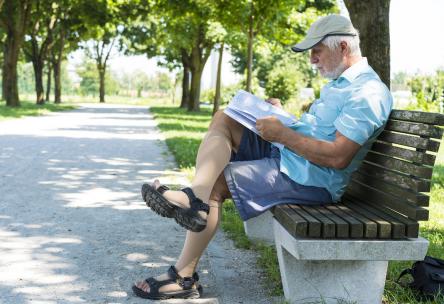Around one-third of the U.S. population will develop varicose veinsat some point in life, but what exactly are they—and do they pose a health risk?

How much do you know about varicose veins? This condition affects more than 40 million people in the United States, yet relatively little is known about these unsightly, ropy bulges. Dr. Rimas Gilvydis, MD, a board-certified vascular and interventional radiologist at the Northern Illinois Vein Clinic and the Gilvydis Vein Clinic, explains the causes, symptoms, and risks—and most important, what you can do about them.
What are varicose veins? Varicose veins develop when your lower-leg veins don’t do their usual job of returning blood to your heart as efficiently as they should. This causes blood to collect in the veins in your lower legs, causing the vein to swell. Although varicose veins may appear to be a cosmetic issue, they are actually a progressive disorder that will get worse over time if not treated, says Gilvydis.
What are the symptoms of varicose veins? You may experience a heavy feeling in your legs, aches and pains, a burning or throbbing sensation, cramping, a restless feeling, and/or itching. These symptoms tend to worsen as the day goes on and you get more tired, especially if you’re on your feet a lot.
Who gets varicose veins? Both men and women suffer from varicose veins, though it’s more common among women. You’re more likely to get them if you have a family history of varicose veins or another vein condition. The problem can also be triggered or worsened by pregnancy, obesity, or an injury or trauma to your legs.
What can untreated varicose veins lead to? If you have varicose veins, you have an increased risk of a far more serious condition called deep vein thrombosis (DVT). “DVT occurs when a blood clot, or thrombus, forms in one of the deep veins in your body, usually your legs,” says Gilvydis. “The clot may then travel to your lungs and cause a pulmonary embolism, which is very serious and sometimes life-threatening.” Symptoms of DVT include pain, warmth, and swelling in your legs. If you suspect you may have DVT, see a vein specialist right away for an evaluation, or head to an emergency department.
How are varicose veins treated? The latest form of treatment for varicose veins is called endovenous laser ablation (EVLA), a minimally invasive procedure in which an ultrasound-guided laser delivers heat to the affected veins, which then collapse (blood naturally reroutes to nearby veins). Most people who undergo EVLA can return to normal activity with little downtime and no scarring.
Can you avoid getting varicose veins? If you’re predisposed to the condition, you may not be able to completely eliminate the risk, but there are ways to reduce discomfort. This includes avoiding sitting or standing for prolonged periods, elevating your legs to promote circulation, maintaining a healthy weight, and avoiding wearing high heels for long periods of time. You can also try compression stockings, but ask your doctor first, says Gilvydis. If you have a job that requires long hours on your feet (such as nurse, doctor, teacher, or flight attendant, among other professions), you may want to pay special attentio